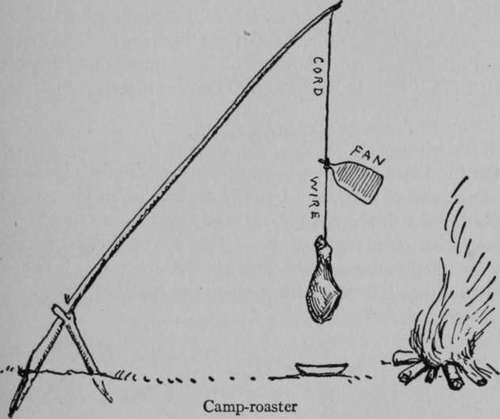Camp Cookery
Description
This section is from the book "The Book Of Woodcraft", by Ernest Thompson Seton. Also available from Amazon: The Book of Woodcraft.
Camp Cookery
(See Horace Kephart's "book of Camping and Woodcraft.")
In most camps the staples are: Coffee (or tea), bacon, game, fish and hardtack, bannocks or biscuit, usually and most appropriately called "sinkers" and "damper".
To make these necessary evils, take:
1 pint flour.
1 teaspoonful of baking-powder,
Half as much salt,
Twice as much grease or lard,
With water enough to make into paste, say one half a pint.
When worked into smooth dough, shape it into wafers, half an inch thick, and three inches across. Set in a greased tin, which is tilted up near a steady fire. Watch and turn the tin till all are browned evenly.
For other and better but more elaborate methods of making bread, see Kephart's book as above.
For cooking fish and game the old, simple standbys are the frying-pan and the stew-pan.
As a general rule, mix all batters, mush, etc., with cold water, and always cook with a slow fire.
There is an old adage:
Hasty cooking is tasty cooking. Fried meat is dried meat. Boiled meat is spoiled meat. Roast meat is best meat.
This reflects perhaps the castle kitchen rather than the camp, but it has its measure of truth, and the reason why roast meat is not more popular is because it takes so much time and trouble to make it a success.
During my Barren Ground trip I hit on a remarkably successful roaster that, so far as I know, was never tried before.
The usual pot-stick is set in the ground (if no tree be near), and the roast hung by a wire and a cord; where they meet is a straight or flat piece of wood, or bark, set in a loop of the wire.

The wind strikes on this, causing the roast to turn; it goes till the cord is wound up then unwinds itself and goes on unceasingly. We used it every day. It was positively uncanny to see the way in which this thing kept on winding and unwinding itself, all day long, if need be.
War Sack
Every brave in camp should have a war-sack. This is a sack of waterproofed canvas to hold clothing and anything that is unbreakable. It has several advantages over a trunk. It is cheap ($1.50), waterproof, light, a comfortable pack to carry or to stow in a canoe, collapsible when empty, safe to float in an upset, and at night it serves as a pillow.
Its disadvantages are that it will not protect breakables, and you have to take out most of the things to find an article not on the top. Nevertheless, all old campers use the war-sack. They can be had of any camp outfitter.
Scout Buttons
On the Plains, when a button is lost or needed, it is easy to make one of leather. Usually a piece of an old strap is is used. cut it the right size, make two holes in it, and sew it on as an ordinary button. This never breaks or fails. As the old plainsman who first showed me, said, "There's a button that'll be right there when the coat's all wore away from behind it".

Lace Or Thong
If you need a lace or thong and have no leather long enough, take a square piece, round the corners, then cut it round and round, till it is all used up. Pull and roll the thong produced, until it is small and even, without kinks.
Continue to:
Tags
bookdome.com, books, online, free, old, antique, new, read, browse, download
